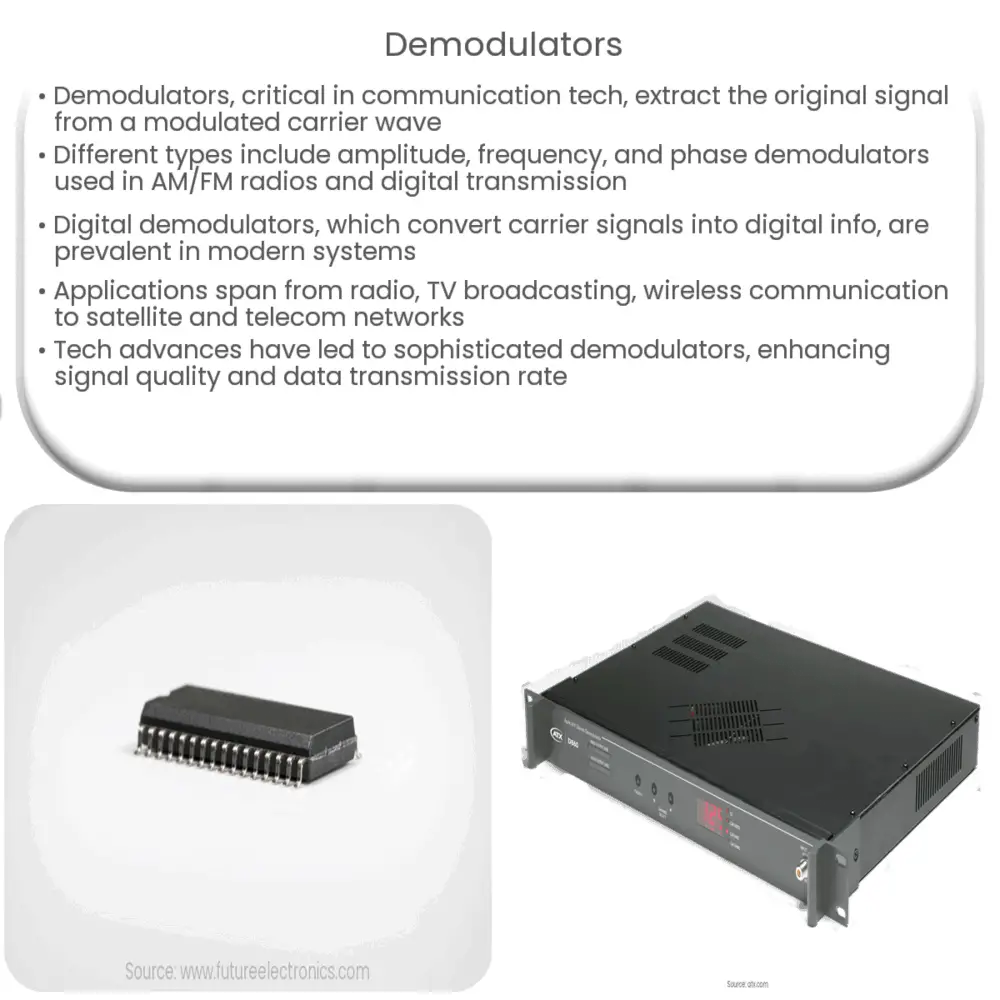Explore the world of demodulators, their types, working principle, applications, and importance in modern communication systems.

Introduction to Demodulators
In the world of communication technology, the term ‘demodulation’ plays a critical role. In essence, a demodulator is a device used to extract the original information-bearing signal from a modulated carrier wave. This process is a pivotal part of telecommunication and signal processing.
The Modulation-Demodulation Process
To understand the concept of a demodulator, one must first grasp the idea of modulation. Modulation is the process of varying one or more properties of a periodic waveform, called the carrier signal, with the modulating signal that typically contains information to be transmitted. Demodulation is, essentially, the reverse of this process.
Types of Demodulators
Demodulators can be categorized into different types based on the method of modulation used:
- Amplitude Demodulation: Also known as AM demodulation, it is used in AM radios where the amplitude of the carrier signal is varied in proportion to the waveform being sent.
- Frequency Demodulation: In this type, used widely in FM radios, the frequency of the carrier signal is altered by the input signal.
- Phase Demodulation: This type is used in digital data transmission, where the phase of the carrier signal is manipulated based on the information being sent.
Working Principle of a Demodulator
A demodulator works by receiving the modulated carrier signal and isolating the original information-bearing signal from it. This is achieved by different methods, depending on the type of modulation. For example, an AM demodulator extracts the envelope of the carrier signal and then removes the carrier frequency, leaving only the original signal behind.
The frequency or phase demodulators, on the other hand, involve more complex procedures. In frequency demodulation, the demodulator tracks changes in the carrier frequency and translates these changes into signal amplitude. Similarly, phase demodulation relies on detecting variations in the phase of the carrier signal.
Demodulators, whether they are part of a radio receiver or a data communication system, have a significant role in ensuring the successful delivery of information. As communication technology advances, demodulators continue to evolve and adapt to support increasingly complex modulation schemes.
Demodulators in Digital Communications
As we progress further into the digital age, the role of demodulators in data communications is growing more important. In modern systems, digital demodulators are commonly used. These devices convert signals from the carrier into digital information. Often, digital demodulation processes involve complex algorithms and require a higher level of signal processing capability.
The Application of Demodulators
The applications of demodulators are vast and wide-ranging. They play a key role in various domains, from broadcasting to wireless communication and beyond.
- Radio and Television Broadcasting: Every time you tune into a radio station or watch a television channel, you are benefiting from the work of demodulators.
- Wireless Communication: Devices like mobile phones and Wi-Fi routers use demodulators to interpret the received signals.
- Satellite Communication: In the field of satellite communication, demodulators help in decoding the signals sent from the satellite.
- Telecommunication Networks: Broadband networks and telecommunication systems heavily rely on demodulators to handle the large volumes of data being transmitted.
Advancements in Demodulator Technology
Technological advancements have enabled the creation of sophisticated demodulators that can handle complex modulation schemes. Such advancements have been instrumental in increasing the data transmission rate and enhancing the quality of signal reception. From the early analog demodulators to today’s high-speed digital demodulators, the evolution of these devices has been remarkable.
Moreover, with the advent of software-defined radios (SDRs), demodulation processes can be executed through software, providing greater flexibility and adaptability. This has opened new avenues for the development and application of demodulators.
Conclusion
In conclusion, demodulators are integral to modern communication systems. They perform the vital function of converting modulated signals back into their original form, enabling the transmission and reception of information across various platforms and devices. As technology advances, the role and capabilities of demodulators are expected to evolve and become even more crucial to digital communication and signal processing. Therefore, a solid understanding of demodulators and their functions is essential for anyone interested in the field of communication and technology.




